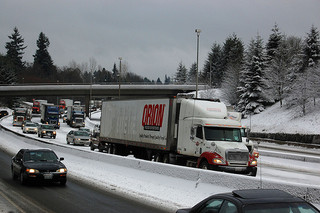<p style="text-align: justify">In many areas of the United States, the price of winter’s beauty and snow sports fun are snowy, icy roads that make for sometimes treacherous driving conditions. Commercial truckers must be able to navigate dangerous driving scenarios daily. From erratic civilian drivers to extreme fatigue, winter ramps up normal road dangers even more.</p>
<p style="text-align: justify"><img class="aligncenter size-full wp-image-9068" alt="Safe Winter Driving: Tips For Truckers" src="https://medusamagazine.com/wp-content/uploads/2013/10/winter-driving.jpg" width="320" height="213" /></p>
<p style="text-align: justify">Here are some driving tips to keep you safe — even as the roads get more dangerous in the winter months.</p>
<h3 style="text-align: justify"><strong>Be Prepared</strong></h3>
<p style="text-align: justify">Connect to your inner Boy Scout, and make sure that you’re always prepared! Think about what you might need if you get stranded on the road for a couple hours or more, depending on your routes. Pack a bag, and include the following items in your cold-weather emergency kit:</p>
<ul style="text-align: justify">
<li>Chemical hand warmers</li>
<li>Blankets</li>
<li>First-aid kit</li>
<li>Flares</li>
<li>Cones</li>
<li>Thick, waterproof gloves</li>
<li>Water</li>
</ul>
<h3 style="text-align: justify"><strong>Prep your Truck</strong></h3>
<p style="text-align: justify">Think about winter-weather friendly adjustments you can make to your truck. For example, the truck’s defroster is the best way to keep the windshield clean, but you’ll want heated wiper blades to remove freshly melted snow. Also, snow chains make hilly roads much easier to travel when snow and ice cover the terrain. Snow chains are actually required in many states, so be sure to check the law before you drive new routes. Check the antifreeze and top off the rest of your fluids, too, while you’re addressing winter-driving issues. Of course, you can break down just as easily in the summer as the winter, but you won’t regret it as much on a breezy day as you do when temperatures are below zero.</p>
<h3 style="text-align: justify"><strong>Keep an Eye on the Weather</strong></h3>
<p style="text-align: justify">The fastest route to any destination isn’t often the one that runs you through a blizzard. Check weather predictions before you get started on your route, and make plans to avoid any areas with huge amounts of snowfall, heavy rain and other hazardous winter weather. Check back regularly to ensure you’re not running straight into the path of a storm. An onboard fleet tracking device can help you stay informed about weather conditions — far in advance.</p>
<p style="text-align: justify">If storms are unavoidable, fill up your gas tank before you hit one. And be sure to check the air pressure on your tires before you head out into potentially bad weather. Also consider over-buying snacks and use the bathroom. You won’t want to navigate slick exit ramps in a storm’s worst points.</p>
<h3 style="text-align: justify"><strong>Know what to Watch for</strong></h3>
<p style="text-align: justify">You probably already know to remain calm and not slam on the brakes when you unexpectedly hit a patch of ice. But do you know how to spot it? Here are some signs that black ice may be a problem for you:</p>
<ul style="text-align: justify">
<li>The temperature is below 32 degrees Fahrenheit.</li>
<li>The road looks wet, but you don’t see other cars spraying water.</li>
<li>Your outside mirrors are iced over.</li>
</ul>
<h3 style="text-align: justify"><strong>Decide if your Route is Safe</strong></h3>
<p style="text-align: justify">Winter driving doesn’t need to be dangerous. If you get an assignment that you don’t feel comfortable taking, pass on it. The best way to stay safe is to use your best judgment on conditions. And if that means staying off the road, that’s the best course of action for you to take. The people who work in your company’s office may not have driving experience and therefore don’t necessarily know when it’s unsafe to drive. Don’t be afraid to speak up and tell them why you think it may be best to hold off on the route. If you get caught in a storm when you’re on the road and don’t think it’s safe to keep driving, seek shelter and wait for it to pass.</p>
<p style="text-align: justify">Safe winter trucking comes down to knowing your truck, your own driving skills and your experience with navigating a large commercial vehicle in hazardous conditions. Rely on your instincts to decide whether to go or stay during the worst winter weather.</p>

Safe Winter Driving: Tips For Truckers
